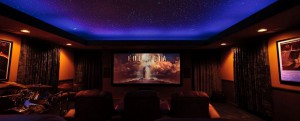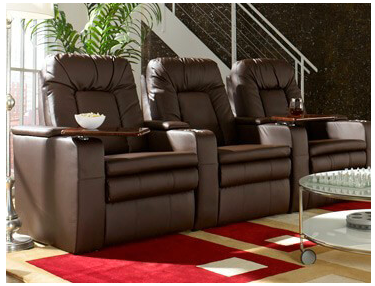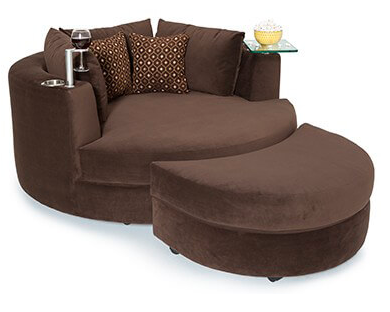
It’s finally here – the anticipation has been building for years and you’re finally ready to execute a new home theater setup! From lighting and sound to projector and TV, the options can be quite overwhelming. The good news is you’re not the first to set up a new media room so learn from others’ mistakes and enjoy creating your new space! Get the scoop on what NOT to do in your new home theater room:
Bad Lighting
There’s nothing that’ll ruin your viewing experience like a glare on your TV screen, or lights that drown out your video projection. For a home theater, the darker the room, the better the experience. If your home theater has windows, don’t place your TV on the wall opposite the windows. Additionally, consider the surface of your TV screen. If it has a matte surface, it should minimize light reflections; but if it has an extra glass-like coating, light sources may create additional reflections, distracting from the picture.

Projector Versus TV
If your mindset is to go big or go home, there’s probably an internal argument going on about whether to get a really big TV or a projector and screen. If you’re looking to get the biggest bang for your buck, you need to take into consideration the cost per inch of picture and the quality of picture, both being inextricably linked.
If a projector and screen combination is what you seek, then be sure to weigh the pros and cons before pulling the trigger. If you’re seeking better brightness, resolution, and color accuracy (just to name a few), a large TV is the way to go. However, if you’re inclined to desire more in the way of size, a projector and screen combo may reign supreme.
Buying the Wrong Size TV

We know you want a big TV –who doesn’t? But, an excessively large TV isn’t always the best option for the size of the room or the viewing distance. For 720p and 1080p HDTVs, the optimal viewing distance from the viewer to the TV should be about 1.5 times the width of the TV screen. If you have a 55-inch Plasma, LCD, or OLED HDTV, for example, sit about seven to nine feet from the screen. With the current trend towards 4K Ultra HD TVs, however, you’ll get a better viewing experience if you sit closer to the TV. On the other hand, if you buy a TV that’s too small, it will be like looking through a tiny window. To ensure you get the best screen size for your space, measure the available width and height you have in the room, and the seating distance from the screen. One of the biggest reasons people return their TVs is because it is either too small or too big to fit the designated space!
Buying Cheap Seats

Don’t cheapen your experience by buying or repurposing conventional house furniture or uncomfortable, but inexpensive seats. One of the best things about having a home theater is having your very own clean, comfortable seats to curl up in. If you’re spending the time and money to design your home theater, you’ll want to invest in seats that will both showcase your style and last you a lifetime. These reclining Seatcraft Excalibur LX Home Theater Seats are made of premium top grain leather (the most durable tier of leather), have ambient floor and cupholder lighting, and come with USB charging stations. Seats like these will definitely take your home theater game to the next level.
Great Image, Awful Surround Sound

You connect and place the speakers and turn everything on, but it doesn’t sound right. You can’t hear dialogue over the rest of the soundtrack, the surround sound effect is too low, and the bass is overwhelming. Help! Try using a sound meter to generate test tones and use the setup program that most theater receivers have to match your speakers’ capabilities to the characteristics of your room. This will help determine the size of the speakers and the optimal distance for listening, and will use this information to adjust the sound output level of each speaker. If you have a medium or large room, a set of floor-standing speakers is probably your best bet because they provide a full range sound and are able to move the sound through larger rooms. If you don’t have a lot of space, a set of bookshelf speakers may be a perfect option.
Not Hitting Budget Margins
Forming an appropriate budget and sticking to it will save you a lot of stress in what may seem like an overwhelming task. In order to do this, consider a variety of brands and models, do your research, avoid prices that seem too good to be true, and don’t devote your entire budget to the big ticket items. More often than not, doorbuster items won’t meet your needs. This doesn’t mean you need to spend a fortune on things like TVs or seating, but consider doing some research to determine which item will fit your preferences and budget. Also, don’t forget about the little guys! It’s easy to overlook things like wires, cables, wall mounts, remote controls, and other accessories that will add up.

Placing Speakers In Cabinets Or Furniture
Despite recent trends of hiding speakers in cabinets, furniture, or behind plants, this will really hurt audio performance. High quality speakers perform their best in an open room; if you put speakers inside cabinets, you essentially undo all the work the designer did to make the speaker sound great. Rather than adding to your home theater experience, you’ll get a muddled, booming sound quality that’s much worse than it would be without extra speakers.

Don’t conclude a movie night and allow your guests to leave your new home theater room in complete disappointment all over their faces! A truly great home theater is more than just the projector and screen – it’s about how it all comes together to give a fully immersive experience! Need some design or home theater advice? Ask our experts at 4seating.com!




